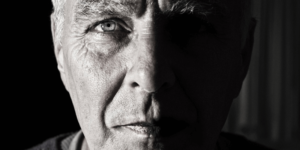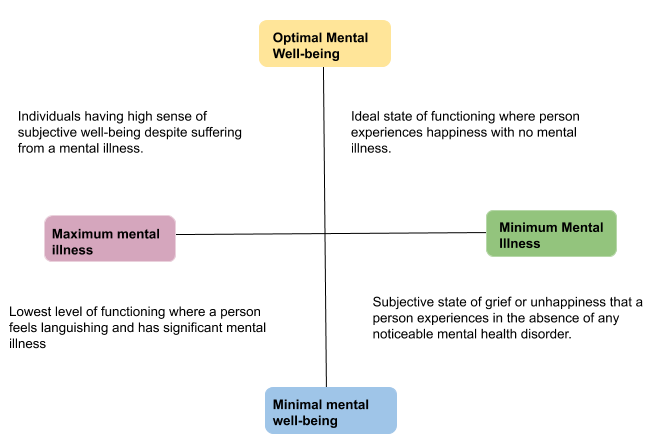What is the Mental Health Continuum Model?
 Think about it. When a person behaves oddly or deviates from the societal standards of normality, we address him/her in so many ways – depressed, anxious, moody, suicidal, and the list goes on.
Think about it. When a person behaves oddly or deviates from the societal standards of normality, we address him/her in so many ways – depressed, anxious, moody, suicidal, and the list goes on.
But how often do we hear ourselves categorizing the ‘mentally healthy’ people as happy, very happy, or well-balanced?
Mental health researchers across the world agree that mental illness is often overindulged in our society, whereas mental health gets less attention than it should. Gordon Allport (1937) mentioned in his studies that mental health and illness are not two independent constructs. They are two poles of a linear sequence and keep moving throughout the lifetime.
According to Allport, a fully developed and well-functioning individual manifests the following features:
- A variety of interests and the zeal to pursue them.
- The ability to accomplish daily responsibilities, including self-care.
- A mature insight into his internal and external worlds.
Failure to perceive or exhibit any of the three qualities indicate a deviation from optimal functioning and would mark a shift from the ‘healthy’ end of the continuum to the ‘unwell’ end of it. This article is a short but in-depth exploration of the mental health continuum model that studies human psyche and psychological disturbances as a unified concept (Frisch, Cornell, Villanueva, & Retzlaff, 1992).
Before you read on, we thought you might like to download our 3 Positive Psychology Exercises for free. These science-based exercises will explore fundamental aspects of positive psychology including strengths, values, and self-compassion, and will give you the tools to enhance the wellbeing of your clients, students, or employees.
This Article Contains:
- What is the Mental Health Continuum? (Definition)
- The Short and Long-form Models Explained
- A Look at the Mental Health Continuum Diagram
- The Mental Health Continuum: From Languishing to Flourishing in Life
- The Illness-Wellness Continuum
- The Continuum of Care Model
- The Be You Mental Health Continuum (incl. PDF)
- A Take-Home Message
- References
What is the Mental Health Continuum? (Definition)
The mental health continuum is a range having mental health and mental illness at the two extreme ends. Depending on the internal and external faculties of a person at any time, he can lie at one point of the continuum and shift position as his situation improves or deteriorates.
There are distinct markers within the mental health continuum:
The Healthy Point
People who lie at this point are generally satisfied and happy in their lives. They are emotionally well-balanced, stable, and goal-oriented.
The Problem Point
This is the mid-range of the continuum. People who lie at this point may show some distress and inability to cope, but are capable of performing daily life functions.
The Disorder Point
This is the end of the continuum, and as the name suggests, people falling under this category are unable to cope with stress and exhibit significant changes in their thoughts, behavior, and actions.
How is it Used?
Mental health continuum model projects the human mind on a continuous linear perspective. It helps in recognizing specific behavioral patterns that may need attention and suggests ways of dealing with the adversities that cause trouble.
The mental health continuum is often used in association with the BETLS (The Behavior, Emotions, Thoughts, Learning, and Social Relationship) model and is widely used for:
- Identifying the underlying causes of impairment in daily life functions.
- Gathering information about the different mental health states of a person over time.
- Indicating when it would be ideal to seek professional assistance for restoring the mental balance.
- Recognizing symptoms of different psychological disorders.
As a reliable self-help tool for professionals at work, the mental health continuum model is a popular choice among leaders and managers of leading organizations today. As a part of organizational psychology, the continuum helps in:
- Identifying the sources of stress among employees at all levels.
- Encouraging employees to grow a healthy mindset that can help them overcome distress and move to the other end of the continuum.
- Maintaining a positive growth mindset among leaders, supervisors, and others in the company.
- Understanding how to identify the mental health symptoms in oneself and others.
- Learning how to deal with the psychological crises effectively and not allowing them to jeopardize our well-being.
The Short and Long-form Models Explained
The long-form and short forms of mental health continuum (MHC) had been developed as a quantifiable and objective analysis of the mental health continuum model. They are self-assessed questionnaires with items that indicate one’s current level of psychological functioning and confirms the implication of the mental health linear model.
The long-form (MHC-LF) was created at first, and it formed the basis of the short-form assessment later.
The items in the MHC-LF and the MHC-SF are categorized into three scales:
- The positive emotional well-being scale.
- The psychological well-being scale.
- The social well-being scale.
The long-form consists of 40 items that assess subjective well-being. The short-form is an abridged version of the MHC-LF that consists of 15 items in total:
- Seven statements measuring emotional well-being.
- Six three-item scales measuring the six dimensions of Ryff’s model of psychological well-being (Ryff, 1989).
- Five three-item scales for assessing the five dimensions of Keyes’ model of social well-being (Keyes, 1998).
Both the tests have high validity and internal consistency reliability, making its usefulness unquestionable for assessing mental health and mental health problems. The long and short forms of the mental health continuum model are useful for the neuropsychological understanding of mental health disorders and their impact on our daily lives (Keyes & Simoes, 2012).
For example, studies on GAD patients and panic attack victims revealed that encouraging them to take the assessments positively impacted the prognosis and reduced the risk of premature mortality (Keyes, Dhingra, & Simoes, 2010).
The forms are successfully used across different healthcare, academic, and disability sectors today. Below are brief illustrations of the two mental health continuum forms. You can learn more about them from the links below.
Mental Health Continuum Long Form – MHC-LF
How strongly do you agree or disagree with each of the following statements?
| Agree | Neutral | Disagree | |||||
|---|---|---|---|---|---|---|---|
| Strongly | Somewhat | A little | Don’t Know | A little | Somewhat | Strongly | |
| I like my personality. | |||||||
| When I look at my life, I feel happy. | |||||||
| I don’t wander aimlessly through life. | |||||||
| The demands of everyday life get me down. | |||||||
| I feel disappointed about my achievements in life. | |||||||
| I have difficulty maintaining relationships. | |||||||
| I take one day at a time and don’t think about the future. | |||||||
| I feel I am in charge of the situation in which I live. | |||||||
| I am good at managing the daily responsibilities of life. | |||||||
| Sometimes I feel that I’ve done all there is to do in life. | |||||||
| For me, life has been a continuous process of learning, changing, and growth. | |||||||
| Having new experiences is exciting and challenging for me. | |||||||
| People describe me as a giving person. | |||||||
| I don’t try to make big improvements or changes in my life anymore. | |||||||
| I am easily influenced by others’ opinions. | |||||||
Access the full MHC-LF.
Mental Health Continuum Short Form – MHC- SF
During the past month, how often have you felt the following?
| Everyday | Almost everyday | 2-3 times a week | About once a week | Once or twice a week | Never | |
|---|---|---|---|---|---|---|
| Happy Interested Satisfied Part of your community Important to your society |
||||||
| Your society is a good place and is changing for the better. People are generally good. You understand how society works. You like most parts of your personality. You feel comfortable performing all the daily responsibilities. |
||||||
| You have loving and trusting relationships with others. Your experiences helped you to become a good person. You are confident to express your ideas. You feel a sense of direction in your life. |
A Look at the Mental Health Continuum Diagram
We experience stress every day, and sometimes it does take a toll on our happiness and well-being. Many of us succeed in overcoming the anxiety and bounce back to life, and their inner balance remains intact. But some unpleasant encounters dishevel the mind, and we might need a little support at those times to get back on our feet.
As the primary responder to stress, we should pay equal importance to the daily struggles as we pay to the more significant adversities. For example, divorce, death, or financial crisis are undoubtedly substantial stressors that can alter our mental stability in a day. But equally potential stressors lie in daily tidbits such as regular arguments with spouse, awkward commuting hazards, an unpleasant work environment, etc..
The theory of MHC states that while identifying which point we lie at the present moment, we must consider all the little things that upset us, and work on minimizing them altogether. The continuum describes the different mental health conditions along with their physiological effects and suggests ways to improve both.
The diagrammatic representation of MHC depicts:
- Healthy and adaptive coping state.
- Mild and reversible distress state.
- Severe and persistent impairment.
- Clinically significant mental disorder.
It is important to remember that we all are capable of moving from one end to the other end of the continuum. Being in the red zone does not imply that we cannot be in the green zone again, and vice versa. Below is a brief description of the main features of the mental health continuum model, followed by an illustration of the MHC diagram.
| Stage | Characteristics | Ways to improve/sustain |
|---|---|---|
| Positive, healthy functioning | Stable mood with minimum fluctuations. Overall calm and peaceful state of mind. Contentment with life. Self-motivated and energetic. Physically healthy. |
Prioritize tasks. Break problems into smaller chunks and address one at a time. Maintain a healthy lifestyle. |
| Neutral, reactive state. | Nervousness and worry. Vulnerability to stress. Feeling overwhelmed. Self-doubt causing anxiety to perform. Tiredness and lack of energy. |
Recognize abilities and limitations. Get a healthy diet plan and fitness regime. Engage in more social activities. Get adequate rest. |
| Damaged and moderately ill | Persistent sadness and feelings of inadequacy. Restlessness and irritability. Lack of motivation to take up new challenges. Overall feeling of apathy and unexplained fatigue to perform daily duties. Deterioration in personal and professional relationships. Substance and drug abuse. |
Self-awareness. Try to get to the root cause of stress. Seek help. Get an emotional support system (e.g., family, friends, kids, therapist, colleagues). |
| Severe mental illness | Extreme anxiety-causing social isolation. Extreme mood swings. Sleeping and eating disorders. Alcohol or drug abuse. Inability to perform daily responsibilities, including basic self-care. Marked deterioration in academic or professional achievements. |
Go for professional assistance. Try to stay around others as much possible. Follow the treatment plan. Try to regain your previous health routine. |
The Mental Health Continuum: From Languishing to Flourishing in Life
Mental health is a state of successful performance of psychological functions, resulting in productive activities, fulfilling relationships with people, and the ability to adapt to change and cope with stress (Jahoda, 1958).
Socialists and clinical psychologists have devoted almost 40 years of research for building a strong groundwork for recognizing mental disorders as ‘a syndrome of symptoms’ that affects well-being. Mental illness does not mean the absence of mental health; it merely implies that the person, at present, lies at the negative end of the continuum.
As a complement to the mental health continuum model, the ‘Languishing vs. Flourishing’ perspective came into the picture. Within this perspective, mental health disorder or an overall distressed state is referred to as ‘languishing,’ whereas, a more positive and content state is called ‘flourishing.’
Studies on this model focused on four fundamental aspects:
- The prevalence of flourishing and languishing in the overall sample population.
- The association of languishing with significant depression and other mental health illnesses.
- The relationship between flourishing and happiness and whether one calls for the other.
- The understanding of mental health and mental health disorders among the general population.
The languishing vs. flourishing model of mental health became significantly popular after the multiple success of its application across different parts of the world. An experiment on adults aged 25-70 years revealed that participants who fitted the flourishing criteria scored higher on happiness scales and did not show any symptoms for depression or burnout.
On the other hand, cross-examination of individuals whose score fell under the languishing criterion showed that they have underlying depression. The risk of major depression, as revealed in the study, was significantly higher among individuals who lied at the languishing end of the scale.
Furthermore, the descriptive details of the study showed that languishing and depression were associated with personality disintegration, and most people who manifested depressive symptoms were the working adult population.
The Illness-Wellness Continuum
Dr. John Travis (1972) created the Illness-Wellness Continuum, intending to inspire people rather than treat them. He formulated the continuum and a Wellness Inventory with some valuable inputs on how lifestyle modification can bring a positive shift in mindset and move us to the wellness end of the continuum.
The concept focuses on building well-being through responsibility, emotional control, deep insight, and mindful, holistic awareness. From media to spiritual guides, Dr. Travis’ work was well-appreciated by all and remained to be one of the most effective life-changing resources that we can find.
The Illness-Wellness Continuum runs on three key concepts of well-being:
- Wellness is a process; it is always moving up and down, right, and left. Moving from one paradigm to another does not signify personal achievement or shortcoming, it is a natural process we all go through at some point in life.
- Presence of illness does not imply the absence of wellness and vice versa. They differ in degree and do not follow an all-or-none principle.
- At any point, we have the potential to push ourselves from illness to wellness.
The Illness-Wellness Model of Travis became famous in 1975 and continues to be the nucleus of many positive psychology interventions and well-being programs.
The Continuum of Care Model
The Continuum of Care Model is an interdisciplinary approach to help individuals and their families who seek mental health assistance. From terminal diseases to childhood problems, and more serious psychological conditions, this pathway benefits individuals by:
- Providing opportunities for patient care through partnership in community programs.
- Catering to the individual needs of clients and their families.
- Ensuring each client gets proper medical assistance when they need.
- Providing support to families who have recently lost their loved one.
- Offering healthcare services and arranging follow-ups for patients with mental health disorders.
- Attending to the quality of services provided by the mental health and care sectors across the region.
The Continuum of Care is a multifaceted model of promoting happiness and well-being across all ages and background. With the broad objective of integrating the healthcare and mental health service sectors, this approach outlines the best in-care and allied services for patients and families (Waikato Health Board, 2004).
It connects a large number of people with painful diseases or other conditions and meets their needs daily. The model encourages patient-doctor relationship and works for bringing change in their mental state that may have been affected by their illness. Successfully used for cancer patients and substance abusers, the Continuum of Care is a praiseworthy initiative to merge health with happiness.
The Be You Mental Health Continuum (incl. PDF)
Be You is an initiative of Beyond Blue, an organization dedicated to providing mental health and volunteering services, both online and in person. With close association to the BETLS (Behaviour, Emotions, Thoughts, Learning, and Social Relationships) theory of mental health, the Be You mental health continuum tool traces specific signs and symptoms of mental disorders from an early stage.
Be You is a favorite choice among educators, childcare supporters, and mental health community workers, as it:
- Provides an opportunity to give accessible training and evidence-based information to students and parents about learning difficulties and overall academic performance.
- Helps them understand the best ways to deal with children coming from demanding and stressful surroundings.
- Organizing mental health records in an accessible directory format and using them when required.
- Spreading awareness of mental health and well-being among parents.
- Providing consultations and support services to children with a learning disability.
The Be You continuum can trace and distinguish mild, moderate, and severe symptoms of mental illness, making it easy for professionals to plan the intervention strategies. It is a noble initiative of bringing together schools, childcare, medical services, and the mental health sector, with the unified aim to promote well-being and happiness among children.
You can learn more about the Be You mental health continuum and download the PDF.
A Take-Home Message
Mental well-being begins with a strong relationship to the self. A healthy and happy person always feel safe to be around himself. Acknowledging the presence of any tension, worries, or overwhelming emotions can go a long way in developing a deeper and more meaningful connection to the self.
The key takeaway of the concept of mental health continuum is that human minds are always moving. We have the potential to drive ourselves from the negative to the not-so negative, and finally to the positive end of the continuum.
The mere transformation that happens during this shift can change our mindset and fill us with positive life energy. So, let us use the continuum to know ourselves, listen to ourselves, and push ourselves toward a happier and more content life.
We hope you enjoyed reading this article. Don’t forget to download our 3 Positive Psychology Exercises for free.
- Allport, G. W. (1937). Personality: A psychological interpretation. New York, NY: Holt.
- Frisch, M. B., Cornell, J., Villanueva, M., & Retzlaff, P. J. (1992). Clinical validation of the Quality of Life Inventory. A measure of life satisfaction for use in treatment planning and outcome assessment. Psychological Assessment, 4(1), 92-101.
- Jahoda, M. (1958). Joint commission on mental health and illness monograph series: Vol. 1. Current concepts of positive mental health. New York, NY: Basic Books.
- Keyes, C. L. M. (1998). Social well-being. Social Psychology Quarterly, 61(2), 121-140.
- Keyes, C. L. M., Dhingra, S. S., & Simoes, E. J. (2010). Change in level of positive mental health as a predictor of future risk of mental illness. American Journal of Public Health, 100(12), 2366-2371.
- Keyes, C. L. M., & Simoes, E. J. (2012). To flourish or not: Positive mental health and all-cause mortality. American Journal of Public Health, 102(11), 2164-2172.
- Ryff, C. D. (1989). Happiness is everything, or is it? Explorations on the meaning of psychological well-being. Journal of Personality and Social Psychology, 57(6), 1069-1081.
- Travis, J. W. (1972). The wellness/illness continuum. Mill Valley, CA: J.W. Travis.
- Waikato Health Board. (2004). Child & adolescent clinical stream: Proposed model of care. New Zealand: Health Waikato Division.
Let us know your thoughts
Read other articles by their category
- Body & Brain (41)
- Coaching & Application (49)
- Compassion (27)
- Counseling (46)
- Emotional Intelligence (23)
- Gratitude (16)
- Grief & Bereavement (19)
- Happiness & SWB (35)
- Meaning & Values (26)
- Meditation (21)
- Mindfulness (42)
- Motivation & Goals (42)
- Optimism & Mindset (33)
- Positive CBT (24)
- Positive Communication (21)
- Positive Education (41)
- Positive Emotions (28)
- Positive Psychology (33)
- Positive Workplace (38)
- Relationships (31)
- Resilience & Coping (33)
- Self Awareness (21)
- Self Esteem (38)
- Software & Apps (23)
- Strengths & Virtues (28)
- Stress & Burnout Prevention (27)
- Theory & Books (42)
- Therapy Exercises (30)
- Types of Therapy (53)






What our readers think
I feel wary of the whole concept of positive psychology movement sensing something toxic under its facade. Human beings do not exist on a linear scale, they are all over the map. I like the way the autism movement has begun to talk about functioning in a much more nuanced way especially as it does not link to negative or positive values. There are so many people across history who have contributed so much to humanity without necessarily being particularly “normal”.
It will help to make my future better life.
The whole article has been an eye opener on what mental health and mental illness is. i have been able to place myself and those around me.
I feel wary of the whole concept of positive psychology movement sensing something toxic under its facade. Human beings do not exist on a linear scale, they are all over the map. I like the way the autism movement has begun to talk about functioning in a much more nuanced way especially as it does not link to negative or positive values. There are so many people across history who have contributed so much to humanity without necessarily being particularly “normal”.
Very interesting read. It puts the concept into perspective in a very simple and precise way. Easy to grasp and understand.
Thank you very much
Talk about an ethnocentric and privileged way to approach those you claim to want to help. This model is so white middle class that it should be tossed in the bin immediately.
Hi Kris,
I’m genuinely curious about your comment – do you mind elaborating a little – if you have moment – on the ways in which it is ethnocentric and middle class?